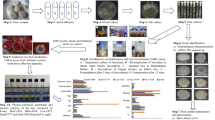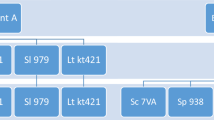Abstract
The study’s objective was to develop a co-fermentation process with appropriate fermentation parameters to produce a sour beer (similar to a Belgium sour beer) with an ethanol content of 6–8% (v/v) using a coculture of Saccharomyces pastorianus and Lactobacillus plantarum. Statistical optimization was conducted to determine fermentation conditions to produce a sour beer with ~ 3 mg/mL of lactic acid, similar to the traditional sour beer levels. Studies were conducted on the microbial dynamics and volatile compounds produced during this fermentation and aging process. GC–MS studies revealed the generation of novel bioactive compounds as well as the depletion of some volatile compounds during co-fermentation. The study detailed a 5-day co-fermentation process of S. pastorianus and L. plantarum and a 21-day aging process to prepare a sour beer with biochemical properties along the lines of traditional lambic beers. The interrelationship between the two microorganisms and the biochemical changes in the sour beer fermentation process was elucidated and the sensorial attributes have been described.



Similar content being viewed by others
References
Panda SK, Behera SK, Qaku XW, Sekar S, Ndinteh DT, Nanjundaswamy H, Ray RC, Kayitesi E (2017) Quality enhancement of prickly pears (Opuntia sp.) juice through probiotic fermentation using Lactobacillus fermentum-ATCC 9338. LWT Food Sci Technol 75:453–459
Liptáková D, Matejčeková Z, Valík, L (2017) Lactic acid bacteria and fermentation of cereals and pseudocereals. In: Jozala A (ed) Fermentation Processes, Croatia, https://doi.org/10.5722/65459.
Panda SK, Kellershohn J, Russell I (2021) Probiotic beverages. Elsevier, UK
Behera SK, Panda SK, Kayitesi E, Mulaba-Bafubiandi AF (2017) Kefir and koumiss. In: Ray RC, Monted D (eds) Fermented Foods, Part II: Technological Interventions. CRC Press, Boca Raton, pp 400–417
Panda SK, Panda SH, Swain MR, Ray RC, Kayitesi E (2015) Anthocyanin rich sweet potato (Ipomoea batatas L.) beer: technology, biochemical and sensory evaluation. J Food Process Preserv 39:3040–3049
Witrick KT (2012) Characterization of aroma and flavor compounds present in lambic (gueuze) beer. Virginia Tech, USA
Chan MZA, Chua JY, Toh M, Liu SQ (2019) Survival of probiotic strain Lactobacillus paracasei L26 during co-fermentation with S. cerevisiae for the development of a novel beer beverage. Food Microbiol 82:541–550
Osburn K, Amaral J, Metcalf SR, Nickens DM, Rogers CM, Sausen C, Caputo R, Miller J, Li H, Tennessen JM, Bochman ML (2018) Primary souring: a novel bacteria-free method for sour beer production. Food Microbiol 70:76–84
Gatto V Binati RL Lemos Junior WJF Basile A Treu L de Almeida OGG Innocente G Campanaro S Torriani S (2020) New insights into the variability of lactic acid production in Lachancea thermotolerans at the phenotypic and genomic level. Microbiol Res 238, https://doi.org/10.1016/j.micres.2020.126525
Market Watch (2017) Sour beers soar. http://marketwatchmag.com/sour-beer-soar/ (Accessed on 22.03.2020).
Mohapatra S, Panda SH, Sahoo SK, Sivakumar PS, Ray RC (2007) β-Carotene-rich sweet potato curd: production, nutritional, and proximate composition. Int J Food Sci Technol 42:1305–1314
Panda SH, Ray RC (2007) Lactic acid fermentation of β-carotene rich sweet potato (Ipomoea batatas L.) into lacto-juice. Plant Foods Hum Nutr 62:65–70
Panda SH, Parmanick M, Ray RC (2007) Lactic acid fermentation of sweet potato (Ipomoea batatas L.) into pickles. J Food Process Preserv 31:83–101
Hamed E, Sakr A (2001) Application of multiple response optimization technique to extended release formulations design. J Control Release 73:329–338
Bartz-Beielstein T, Chiarandini M, Paquete L, Preuss M (2010) Experimental methods for the analysis of optimization algorithms. Springer, Berlin
Palmer JJ (2006) How to brew. Brewers Publication, Maston
Dubey RC, Maheswari DK (2004) Practical microbiology, 1st edn. S. Chand and Co., India
Amerine MA, Ough C (1980) Methods for analysis of musts and wines.Wiley-Inter Science Publication. John Wiley and Sons. New York.
FSSAI (2019) https://old.fssai.gov.in/Portals/0/Pdf/Draft_Manuals/ALCOHOLIC_BEVERAGES.pdf (Accessed on 01.09.2020)
Marxen KK, Vanselow H, Lippemeier S, Hintze R, Ruser A, Hansen U (2007) Determination of DPPH radical oxidation caused by methanolic extracts of some microalgal species by linear regression analysis of spectrophotometric measurements. Sensors 7:2080–2095
Strong G, England, K (2015) Beer Judge Certification Program: style guidelines. Brew. Assoc. 2015, 47. https://legacy.bjcp.org/docs/2015_Guidelines_Beer.pdf
Nam SN, Cho H, Han J, Her N, Yoon J (2018) Photocatalytic degradation of acesulfame K: optimization using the Box-Behnken design (BBD). Process Safety Environ Protect 113:10–21
Witrick KT, Pitts ER, O’Keefe SF (2020) Analysis of lambic beer volatiles during aging using gas chromatography–mass spectrometry (GCMS) and gas chromatography–olfactometry (GCO). Beverages 6(2):31
Tonsmeire M (2014) American sour beer: innovative techniques for mixed fermentations. Brewers Publications, Maston
Pérez-Ruiz T, Martı́nez-Lozano C, Tomás V, Martı́n J (2004) High-performance liquid chromatographic separation and quantification of citric, lactic, malic, oxalic and tartaric acids using a post-column photochemical reaction and chemiluminescence detection. J Chromatography A 1026:57–64
Dysvik A, La Rosa SL, Buffetto F, Liland KH, Myhrer KS, Rukke EO, Wicklund T, Westereng B (2020) Secondary lactic acid bacteria fermentation with wood-derived xylooligosaccharides as a tool to expedite sour beer production. J Agric Food Chem 68(1):301–314
Ciosek A, Rusiecka I, Poreda A (2020) Sour beer production: impact of pitching sequence of yeast and lactic acid bacteria. J Inst Brew 126(1):53–58
Rouse S, van Sinderen D (2008) Bioprotective potential of lactic acid bacteria in malting and brewing. J Food Protect 71:1724–1733
Attchelouwa CK, Aka-Gbézo S, N’guessan FK, Kouakou CA, Djè MK, (2017) Biochemical and microbiological changes during the Ivorian sorghum beer deterioration at different storage temperatures. Beverages 3(3):43. https://doi.org/10.3390/beverages3030043
Preedy VR (2009) Beer in health and disease prevention. Elsevier, California
Ditrych M, Kordialik-Bogacka E, Czyżowska A (2015) Antiradical and reducing potential of commercial beers. Czech J Food Sci 33:261–266
Shahidi F, Ambigaipalan P (2015) Phenolics and polyphenolics in foods, beverages and spices: antioxidant activity and health effects–a review. J Funct Food 18:820–897
Lentz M (2018) The impact of simple phenolic compounds on beer aroma and flavor. Fermentation 4(1) https://doi.org/10.3390/fermentation4010020
Gerhäuser C (2009) Phenolic beer compounds to prevent cancer. In: Preedy V (ed) Beer in health and disease prevention. Elsevier, California, pp 669–684
Pontonio E Montemurro M Pinto D Marzani B Trani A Ferrara G Mazzeo A Gobbetti M Rizzello CG (2019). Lactic acid fermentation of pomegranate juice as a tool to improve antioxidant activity. Front Microbiol 10, https://doi.org/10.3389/fmicb.2019.01550
Verni M, Verardo V, Rizzello CG (2019) How fermentation affects the antioxidant properties of cereals and legumes. Foods 8(9) 362: 10.3390/foods8090362
Abubakar MN, Majinda RR (2016) GC-MS analysis and preliminary antimicrobial activity of Albizia adianthifolia (Schumach) and Pterocarpus angolensis (DC). Medicines 3(1):3. https://doi.org/10.3390/medicines3010003
El-Zaeddi H, Martínez-Tomé J, Calín-Sánchez Á, Burló F, Carbonell-Barrachina ÁA (2016) Volatile composition of essential oils from different aromatic herbs grown in Mediterranean regions of Spain. Foods 5(2): 41; https://doi.org/10.3390/foods5020041.
Sivakumar G (2013) Colchicine semisynthetics: chemotherapeutics for cancer? Curr Med Chem 20:892–898
Karthikeyan BA, Rajasekaran C (2016) Gas chromatography-mass spectrometry (GC-MS) analysis of ethanolic extracts of Barleria acuminata Nees. Int J Pharmacol Res 6:55–71
Ojima I, Iula DM (1999) New approaches to the syntheses of piperidine, izidine, and quinazoline alkaloids by means of transition metal catalyzed carbonylations. In: Pelletier SW (ed) Alkaloids: chemical and biological perspectives. Elsevier, Oxford, pp 371–410
Witrick KT, Duncan SE, Hurley KE, O’Keefe SF (2017) Acid and volatiles of commercially-available lambic beers. Beverages 3(4):51. https://doi.org/10.3390/beverages3040051
Furukawa S Yoshida K Ogihara H Yamasaki M Morinaga Y (2010) Mixed-species biofilm formation by direct cell-cell contact between brewing yeasts and lactic acid bacteria. Biosci Biotechnol Biochem https://doi.org/10.1271/bbb.100350
Dysvik A, La Rosa SL, Liland KH, Myhrer KS, Østlie HM, De Rouck G, Rukke EO, Westereng B, Wicklund T (2020) Co-fermentation involving Saccharomyces cerevisiae and Lactobacillus species tolerant to brewing-related stress factors for controlled and rapid production of sour beer. Front Microbiol 11:279. https://doi.org/10.3389/fmicb.2020.00279
Hair JF, Anderson RE, Tatham RL, Black WC (1998) Multivariate data analysis, 5th edn. Pearson Education Inc., Upper Saddle River, NJ
Stevens JP (1992) Applied multivariate statistics for the social sciences. Lawrence Erlbaum Associates Inc, New Jersey
Bossaert S, Crauwels S, De Rouck G, Lievens B (2019) The power of sour-a review: old traditions, new opportunities. BrewingScience 72(3–4):78–88
Author information
Authors and Affiliations
Contributions
SKP conceived the idea and designed the experiments. SM, RKM, SHP, and SS conducted the experiments. PSS, GD, and PP supported the biochemical and statistical analyses and interpretations. All the authors have supported SKP in drafting the article.
Corresponding author
Ethics declarations
Conflict of interest
The authors declare no competing interests.
Additional information
Publisher’s note
Springer Nature remains neutral with regard to jurisdictional claims in published maps and institutional affiliations.
Supplementary Information
Below is the link to the electronic supplementary material.
Rights and permissions
About this article
Cite this article
Mahanta, S., Sivakumar, P.S., Parhi, P. et al. Sour beer production in India using a coculture of Saccharomyces pastorianus and Lactobacillus plantarum: optimization, microbiological, and biochemical profiling. Braz J Microbiol 53, 947–958 (2022). https://doi.org/10.1007/s42770-022-00691-8
Received:
Accepted:
Published:
Issue Date:
DOI: https://doi.org/10.1007/s42770-022-00691-8




